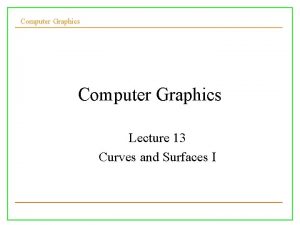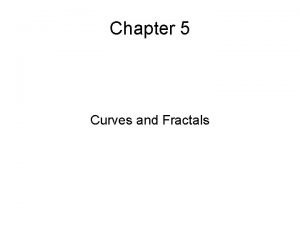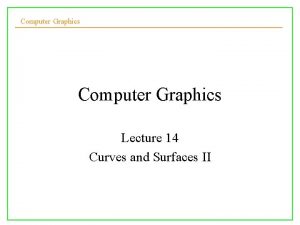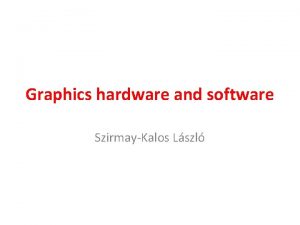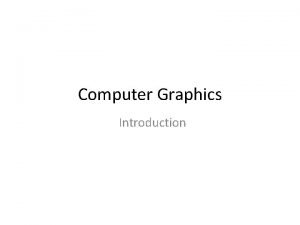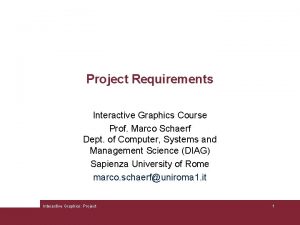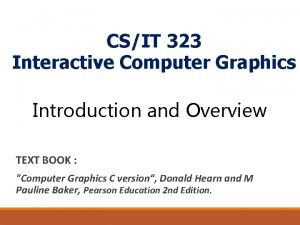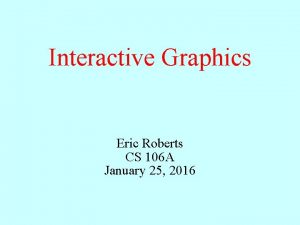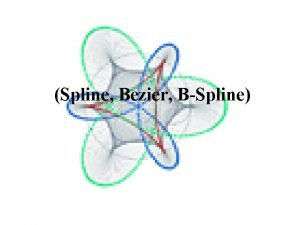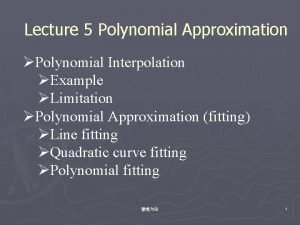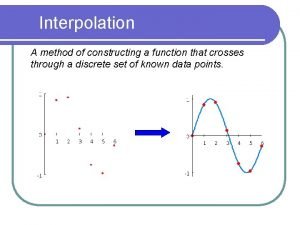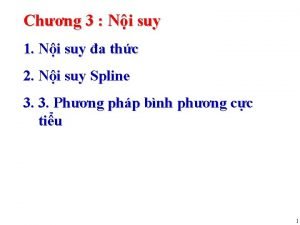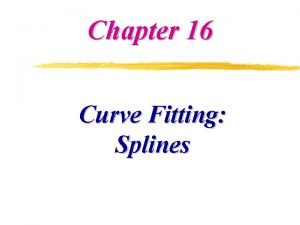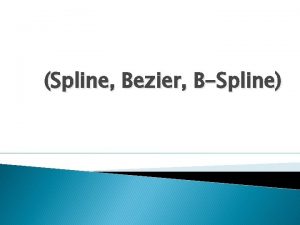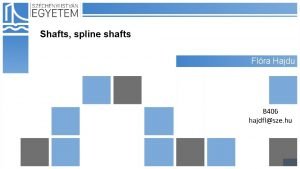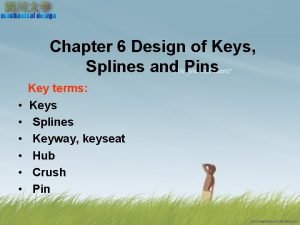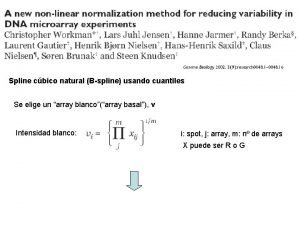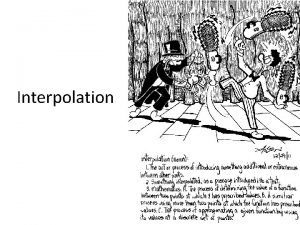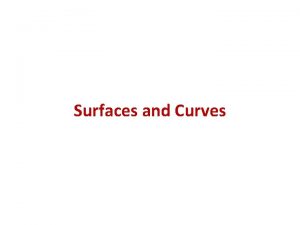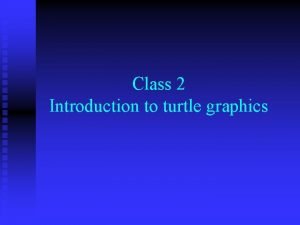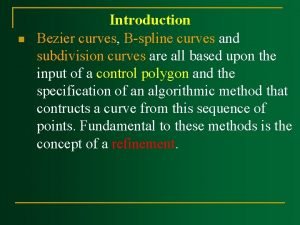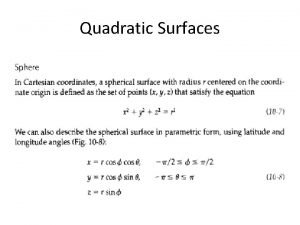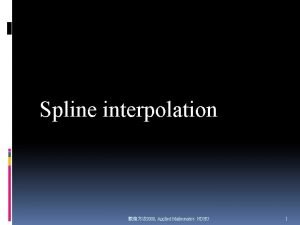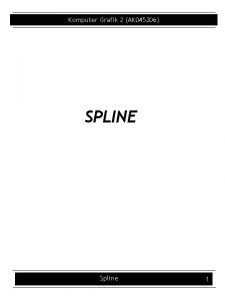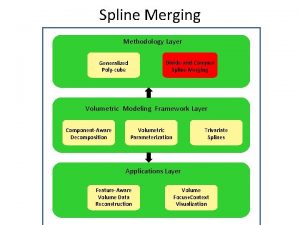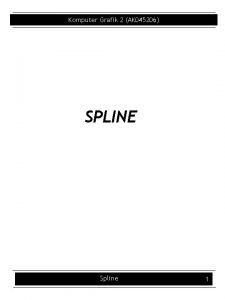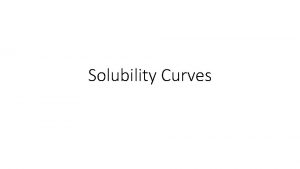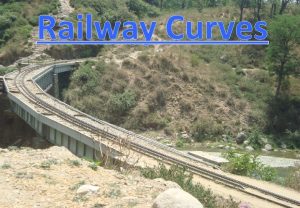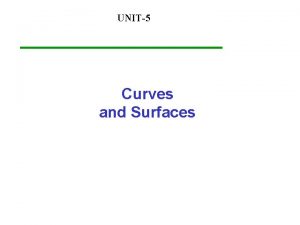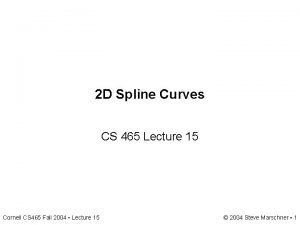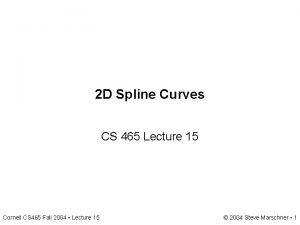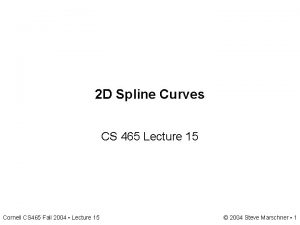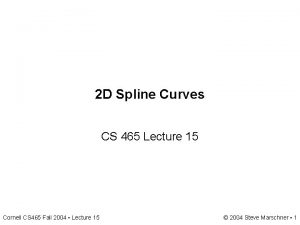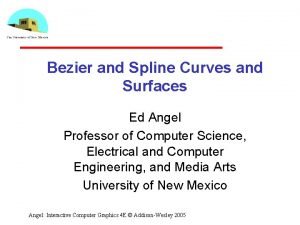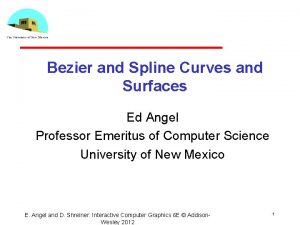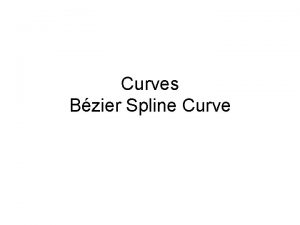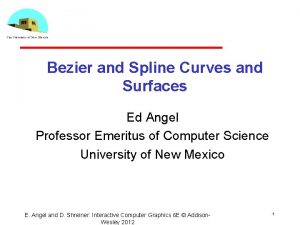Interactive Graphics Lecture 9 Introduction to Spline Curves




































- Slides: 36

Interactive Graphics Lecture 9: Introduction to Spline Curves

Interactive Graphics Lecture 13: Slide 2

Splines The word spline comes from the ship building trade where planks were originally shaped by bending them round pegs fixed in the ground. Originally it was the pegs that were referred to as splines. Now it is the smooth curve that is called a spline.

Interpolating Splines Modern splines are smooth curves defined from a small set of points often called knots. In one main class of splines, the curve must pass through each point of the set. These are called interpolating splines

Approximating Splines In other cases the curves do not pass through the points. The points act as control points which the user can move to adjust the shape of the curve interactively

Non Parametric Spline The simplest splines are just equations in x and y (for two dimensions) The most common is the polynomial spline: y = a 2 x 2 + a 1 x + a 0 given three points we can calculate a 2 a 1 and a 0

A non parametric (parabolic spline) There is no control using non parametric splines. Only one curve (a parabola) fits the data.

Parametric Splines If we write our spline in a vector form we get: P = a 2 2 + a 1 + a 0 which has a parameter by convention, as ranges from 0 to 1 the point P traces out a curve.

Calculating simple parametric splines We can now solve for the vector constants a 0 a 1 and a 2 as follows. Suppose we want the curve to start at point P 0 = a 2 2 + a 1 + a 0 we have =0 at the start so P 0 = a 0

Calculating simple parametric splines Suppose we want the spline to end at P 2 we have that at the end = 1 thus P 2 = a 2 2 + a 1 + a 0 = a 2 + a 1 + P 0

Calculating simple parametric splines and in the middle (say = 1/2) we want it to pass through P 1 = a 2 2 + a 1 + a 0 = a 2 + a 1 + P 0 We have enough equations to solve for a 1 and a 2. Notice that this formulation is the same in 2 and 3 dimensions.

Possibilities using parametric splines

Higher order parametric splines Parametric polynomial splines must have an order to match the number of knots. 3 knots - quadratic polynomial 4 knots - cubic polynomial etc. Higher order polynomials are undesirable since they tend to oscillate

Spline Patches To get round the problem, we can piece together a number of patches, each patch being a parametric spline.

Cubic Spline Patches The simplest, and most effective way to calculate parametric spline patches is to use a cubic polynomial. P = a 3 3 + a 2 2 + a 1 + a 0 This allows us to join the patches together smoothly

Choosing the gradients

Calculating a Cubic Spline Patch P = a 3 3 + a 2 2 + a 1 + a 0 for a patch joining points Pi and Pi+1 we have =0 at Pi and =1 at Pi+1 Substituting these values we get Pi = a 0 Pi+1 = a 3 + a 2 + a 1 + a 0

Calculating a Cubic Spline Patch differentiating P = a 3 3 + a 2 2 + a 1 + a 0 we get P’ = 3 a 3 2 + 2 a 2 + a 1 substituting for =0 at Pi and =1 at Pi+1 we get P'i = a 1 P'i+1 = 3 a 3 + 2 a 2 + a 1

Calculating a Cubic Spline Patch Putting these four equations into matrix form we get:

Calculating a Cubic Spline Patch Finally, inverting the matrix gives us the result we want. Notice that the matrix is the same for every patch

Bezier Curves Bezier curves were developed as a method for CAD design. They give very predictable results for small sets of knots, and so are useful as spline patches. The main characteristics of Bezier curves are They interpolate the end points The slope at an end is the same as the line joining the end point to its neighbour

A typical Bezier Curve

Casteljau’s Algorithm Bezier curves may be computed and visualised using a geometric construction due to Paul de Casteljau. Like a cubic patch, we need a parameter which is to be 0 at the start of the curve, and 1 at the end. A construction can be made for any value of

Casteljau’s Construction = 0. 25

Casteljau’s Construction = 0. 5

Casteljau’s Construction = 0. 75

Bernstein Blending Function Splines (including Bezier curves) can be formulated as a blend of the knots. Consider the vector line equation P = (1 - )P 0 + P 1 It is a linear ‘blend’ of two points, and could also be considered the 2 point Bezier curve!

Blending Equation Any point on the spline is simply a blend of all the other points. For N+1 knots we have: where W is the Bernstein blending function

Expanded Bezier Equations 2 Point: P 0(1 - ) + P 1 3 Point: P 0(1 - ) + 2 P 1(1 - ) + P 2 4 Point: P 0(1 - ) + 3 P 1(1 - ) + 3 P 2(1 - ) + P 3 etc

Bezier Curves lack local control Since all the knots of the Bezier curve all appear in the blend they cannot be used for curves with fine detail. However they are very effective as spline patches.

Four point Bezier Curves and Cubic Patches Four point Bezier curves are equivalent to cubic patches going through the first and last knot (P 0 and P 3) It is possible to show their equivalence in two ways: Expanding the iterative blending equation Reversing the de Casteljau algorithm

Expanding the blending equation For the case of four knots we can expand the Bernstein blending function to get a polynomial in : This can be multiplied out to give an equation of the form: where:

Casteljau’s algorithm gives the same result We start from point P 3, 0 and express it in terms of its construction line. Then the process is continued.

Continuing expanding We can drop the first subscript (which indicates the recursion level) to get: which is the same as before

Control Points We can summarise the four point Bezier Curve by saying that it has two points that are interpolated and two control points. The curve starts at P 0 and ends at P 3 and its shape can be determined by moving control points (P 1 and P 2). This could be done interactively using a mouse.

In summary The simplest and most effective way to draw a smooth curve through a set of points is to use a cubic patch. If no interaction is needed setting the gradients by the central difference (Pi+1 - Pi-1)/2 is effective. If the user wants to interactively adjust the shape the four point Bezier formulation is ideal
 Computer
Computer What are curves in computer graphics
What are curves in computer graphics Curves and surfaces for computer graphics
Curves and surfaces for computer graphics Cs 418 interactive computer graphics
Cs 418 interactive computer graphics Glcreatebuffer
Glcreatebuffer Interactive input
Interactive input Interactive graphics software and hardware
Interactive graphics software and hardware Calligraphic refresh graphics display
Calligraphic refresh graphics display Interactive graphics sapienza
Interactive graphics sapienza Cs 418 uiuc
Cs 418 uiuc What are the components of interactive computer graphics
What are the components of interactive computer graphics The component of interactive computer graphics are
The component of interactive computer graphics are Cs 418 interactive computer graphics
Cs 418 interactive computer graphics Cs 418 interactive computer graphics
Cs 418 interactive computer graphics Interactive computer graphics examples
Interactive computer graphics examples Interactive graphics utah
Interactive graphics utah 01:640:244 lecture notes - lecture 15: plat, idah, farad
01:640:244 lecture notes - lecture 15: plat, idah, farad Graphics monitors and workstations in computer graphics
Graphics monitors and workstations in computer graphics Computer graphics introduction ppt
Computer graphics introduction ppt U4ilui-din8 -site:youtube.com
U4ilui-din8 -site:youtube.com Spline interpolation vs polynomial interpolation
Spline interpolation vs polynomial interpolation Site:slidetodoc.com
Site:slidetodoc.com Spline bậc 3
Spline bậc 3 Quadratic spline interpolation matlab
Quadratic spline interpolation matlab Spline terminology
Spline terminology Spline shaft technical drawing
Spline shaft technical drawing Taper key design
Taper key design Cbico
Cbico Spline
Spline 주식 평균단가 엑셀
주식 평균단가 엑셀 B spline curve definition
B spline curve definition B-spline example
B-spline example Thin plate spline
Thin plate spline Introduction to biochemistry lecture notes
Introduction to biochemistry lecture notes Introduction to psychology lecture
Introduction to psychology lecture Introduction to algorithms lecture notes
Introduction to algorithms lecture notes From turtle import *
From turtle import *
